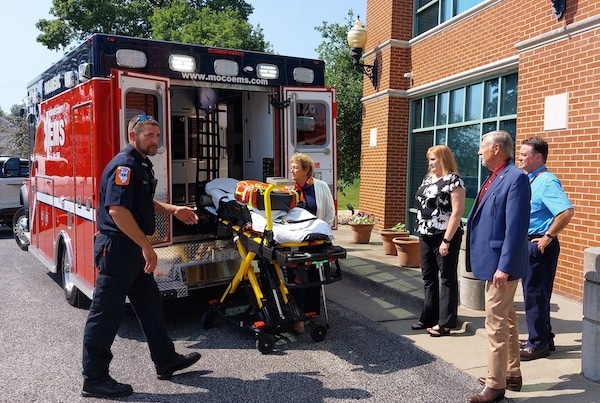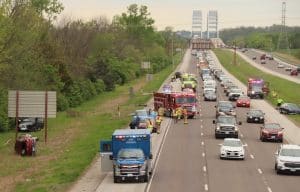Coroner’s office duties explained
During the first of what will be regular updates from the Monroe County Coroner’s Office, deputy coroner Theresa Hitzemann gave the Monroe County Board an overview of what her department does during Monday’s meeting.
“There’s a lot of people in this building (the Monroe County Courthouse) who say to me, ‘I see you every week, and I kinda know what you do, but I don’t really get it,’” Hitzemann began.
She continued by saying the most common misconception about the coroner’s office is that its sole responsibility is pronouncing people dead.
Hitzemann explained that the pronouncements are “the most visible part because that’s what’s in the paper, but it’s really just the first step in a process that can be either really quick depending on circumstances, or it can be many, many, many steps and drawn out over a long period of time.”
The primary responsibility of the coroner’s office, according to Hitzemann, is to determine the cause of each death that occurs in Monroe County.
The coroner’s office consists of Monroe County Coroner Bob Hill, Hitzemann and three other deputy coroners.
Hitzemann said on-call duties are shared among the staff, as she is the only one in the coroner’s office who does not also have a full-time job in addition to her duties as deputy coroner.
Since the positions require availability at all times, Hitzemann said a schedule is produced monthly which is fairly strictly followed, adding she and Hill are responsible for about 70 percent of on-call duties.
The schedule is then shared with Monroe County 911 dispatchers so they know who to contact in the event of a death.
When the coroner’s office is contacted, Hitzemann said they will be told one of two things, either they have a “call to return” or they need to “report to a certain address.”
The call to return is generally from a hospice company or nursing facility, in which case a nurse or person in a similar position is interviewed over the phone.
If nothing there arouses suspicion, a report is filed and the deceased individual is released to a funeral home.
If there had been a recent fall or other incident, Hill will investigate further to determine cause of death.
Hitzemann shared an unusual incident which happened last month when Hill was notified of a death of the young man who had been undergoing rehabilitation at a nursing facility in Monroe County.
Since the individual was young and a paraplegic, Hill investigated further and learned the individual’s injuries may have been sustained during a crime in St. Louis.
The coroner’s office is now working with the St. Louis City Police Department, and Hitzemann said it would “likely” be the first registered homicide case in Monroe County in six years.
While calls from hospice agencies or nursing homes are typically straightforward, Hitzemann said “field calls can run the gamut” of scenarios.
Sometimes field calls can be as simple as a natural death of someone with documented health issues.
Those can be “quick and easy cases,” Hitzemann said, adding, “Unfortunately, we’re seeing fewer and fewer of those types of calls.”
One recent phenomenon Hitzemann described is doctors refusing to sign death certificates, which reverts the case back to the coroner’s office.
Hitzemann said in some cases, the doctor does not have all the information he would like and refuses to sign.
“If we don’t do an autopsy on someone who is 95, or it’s a patient (the doctor) hasn’t seen in a while, they don’t feel comfortable signing off, so then we’ll pull medical records and try to come to a determination ourselves,” Hitzemann explained.
Other field calls the coroner’s office responds to include drug overdoses, traffic crashes and suicides.
“Unfortunately, we’ve had a lot of suicides in the past few years,” Hitzemann said. “It used to be one every other year, now we’re working multiple (suicides) every year.”
She also noted it is sometimes difficult to discern the difference between a suicide and an overdose, especially if the individual does not leave a letter.
Hitzemann also spoke about situations which prolong the coroner’s involvement in a case.
Whenever multiple agencies are involved, such as crime scene investigators or accident reconstruction crews, the process is prolonged.
Also, in cases of indigent individuals or those who do not have any known family members, officially determining the cause of death may take more time.
Hitzemann also shared a death from a few years ago during which a deceased individual was found on the banks of the Mississippi River in Monroe County.
Since there had not been any reports of incidents upriver and the individual did not have any identification, the coroner’s office had to use dental records to identify the individual first before it began the task of determining a cause of death.
Hitzemann concluded her presentation by sharing the number of calls the coroner’s office has received lately.
In June alone, the office received 22 calls. Two required autopsies, including the previously mentioned nursing home call.
The coroner’s office has ordered six total autopsies this year.
To date, the coroner’s office has had 116 calls, with 26 of those being field calls.
In other business from the meeting, Monroe County EMS Director Carla Heise was on hand to discuss the county’s “no treat, no transport” policy which has been in effect for the past six months.
At the beginning of the year, commissioners decided not to charge for service calls which did not require medical treatment or transport by ambulance.
The calls consist mostly for lift assists for elderly residents who have fallen and cannot get up without help.
Heise said to date those types of calls would have cost about $18,000. She also said the program has not been “abused” by people using the free service as an alternative to visiting a physician.
Commissioner Vicki Koerber asked Monroe County Public Safety Director Kevin Scheibe if the public safety budget could support a roughly $40,000 annual write-off to continue not charging for such calls, noting the annual cost would fluctuate depending on need.
Scheibe said the county could easily absorb the cost.
Heise then pointed out it was nice to see Monroe County EMS in a position to offer the service when just a few years ago, the department was in such dire financial straits it was in danger of being eliminated.
Commissioners also agreed they liked the policy, with Commissioner Doug Garmer and Koerber both expressing satisfaction that the county could provide what amounted to a public service for its residents.
Koerber expressed a desire to keep the policy going with six-month updates. In order to do so, Monroe County State’s Attorney Ryan Webb advised commissioners to have Heise bring a resolution before the board every six months.
Commissioners were also given a tour of a remounted ambulance and the new EMS quick response vehicle on Monday.

Monroe County EMS paramedic Matt Liefer pointed out the remounted ambulance box was equipped with a Stryker stretcher system, a motorized system which lowers and lifts the stretcher to and from the ambulance.
The quick response vehicle is a Ford Explorer which will be used to respond to calls such as lift assists which do not require the medical equipment housed in the ambulances, thereby keeping units in service in the event of another call for service.
In other business, Monroe County Engineer Aaron Metzger updated commissioners on a flood mitigation plan in Maeystown.
The topic was discussed last month after a storm flooded the Maeystown Fire Department headquarter in the Maeystown Civic Association Park.
Metzger said the county will be installing a new, larger culvert along Baum Road, and commissioners approved a resolution authorizing funding for the project not to exceed $100,000.
The next meeting of the Monroe County Board will be Monday, Aug. 5 at the Monroe County Courthouse.
Meeting agendas may be found on the county website, monroecountyil.gov.






